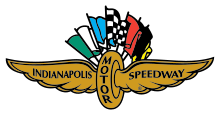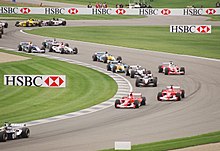Indianapolis Motor Speedway
A modern, FIA Grade One infield road course was completed in 2000, incorporating part of the oval, including the main stretch and the southwest turn, measuring 2.605 mi (4.192 km).
[8] Indianapolis businessman Carl G. Fisher first envisioned building the speedway in 1905 after assisting friends racing in France and seeing that Europe held the upper hand in automobile design and craftsmanship.
The group incorporated the Indianapolis Motor Speedway Company on March 20, 1909, with a capitalization of $250,000, with Fisher and James Allison in for $75,000 apiece and Frank Wheeler and Arthur Newby on board for $50,000 each.
This was originally planned as a two-day, 15-race program, but ended before the first day was completed due to concerns over suitability of the track surface for motorcycle use.
[9] The first day of car racing resulted in four finishes and two land speed records, but concerns over safety led AAA officials to consider canceling the remaining events.
1910 also saw the speedway host the National Aviation Meet, featuring Wilbur and Orville Wright and highlighted by Walter Brookins setting a world record by taking a plane up to 4,938 feet (1,505 m).
With the end of the war in sight, on November 29, 1944, three-time 500 winner Wilbur Shaw came back to do a 500-mile (800 km) tire test approved by the government for Firestone.
Stands have been built and remodeled many times over, suites and museums were added, and many other additions helped bring back Indy's reputation as a great track.
Graham Hill won the following year in his first attempt, eventually becoming the only driver to date to achieve auto racing's "Triple Crown of Motorsport" of winning the Monaco Grand Prix, Indianapolis 500, and Le Mans 24 Hours.
This track was known as the "Indianapolis of the West" and the home of the California 500, but was a financial failure due to poor management and not holding enough races on the racetrack.
By the late 1970s there arose some resistance from certain car owners and drivers as to the direction being taken by USAC, the auto racing sanctioning body that among other things, governed the Indianapolis 500 event.
After a court injunction in favor of CART, and a controversy where exhaust pipe rules were clarified after qualifications began and certain teams with an altered exhaust pipe were "locked into" the field, USAC held an additional qualification round on the day before the race, announcing that any driver who could post a faster speed than the slowest qualifier (Roger McCluskey) would be allowed to start the race.
[26] The 1980s brought a new generation of speedsters, led by four-time race winner Rick Mears who also broke the 220 mph (350 km/h) speed mark in qualifying (1989) and won six pole positions.
Rick Mears became the third four-time winner after a late-race duel with Michael Andretti in 1991, and in 1992, Al Unser Jr. eked out a hard-fought victory by defeating last-place-starting driver Scott Goodyear by 0.043 of a second, a margin that is still the closest finish in race history.
Roger Penske then elected to move his entire operation over to the IRL beginning in 2002, taking Castroneves and teammate Gil de Ferran with him.
Castroneves repeated his Indianapolis 500 win in 2002 despite controversial circumstances involving a late-race caution and a pass made by Tracy, and his teammate de Ferran won in 2003.
At the time, Rice drove for the team co-owned by 1986 Indianapolis 500 winner Bobby Rahal and the Indiana native television talk show host and comedian David Letterman.
In 2005, Danica Patrick became the first female driver to lead the race at Indianapolis, after acquiring it for a lap near the 125 mi (201 km) mark while cycling through pit stops.
[10] Sam Hornish Jr. became the first driver to ever overtake for the lead on the race's final lap, ultimately winning the 2006 Indianapolis 500 in the last 450 feet (140 m) by a 0.0635-second margin over rookie Marco Andretti.
[10] The 2010, 2011 and 2012 runnings of the race saw three consecutive British victories, namely for previous winners Franchitti (2010 and 2012) and the late Wheldon winning in 2011 just a few months before his fatal crash at Las Vegas.
In spite of heavy crashes, the speedway had now gone more than 20 years without a fatality as the SAFER barriers and the enhanced IndyCars absorbed more of the violent impacts.
[33] Known for a time as Kroger Super Weekend, it also previously hosted the Brickyard Grand Prix for the TUDOR United Sports Car Championship on the infield road course.
[34] A two-year renovation and construction project added an infield road course, new pit garages and a new Pagoda building containing race control and the media center.
The 2002 United States Grand Prix was marred by a bizarre ending, in which Michael Schumacher, having already clinched the championship, seemingly tried to stage a dead heat with teammate Rubens Barrichello.
[40] Beginning in 2014, the IndyCar Series began holding a race on the combined road course in early May, serving as a lead-in to the Indianapolis 500.
[43] In addition to multiple classes of racing on the road course, oval track exhibitions featuring historical Indy cars have also been part of the event.
[46][47] From 1960 to 1968,[48] the Speedway Golf Course hosted a PGA Tour event, the 500 Festival Open Invitation; its earlier editions were held during the days surrounding the Indy 500 race week.
[49] A reconstruction project was completed in 1993, converting the 27-hole layout (18 holes outside, nine in the infield) to an 18-hole championship course designed by legendary golf architect Pete Dye.
The opening of the Indianapolis Motor Speedway in 1909 dates back close to the birth of the sport of American Championship car racing.
The Speedway and the city of Indianapolis are closely tied to Indy car racing, analogous to the link NASCAR has to the greater Charlotte area.


















